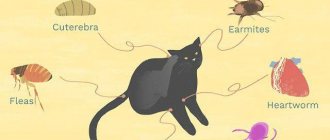What will you learn from the article?
- Where does a cat get worms?
- Symptoms
- Types of worms Tapeworms (cestodes)
- Roundworms (nematodes)
- Flukes (trematodes)
- Medicines for helminths
Helminths (worms in cats) are a very common parasitic disease that can pose a serious threat to the health and life of a pet. From this article you will learn what to do in case of helminthiasis, how to deworm (what anthelmintic drugs to give) and, most importantly, how to prevent your cat from becoming infected with parasites.
Where does a cat get worms?
Not only stray animals can become infected with helminthiasis. Worms occur quite often in cats that live in apartments and private houses. Of course, free-ranging pets are at greatest risk of infection. Helminth eggs can be found on grass, sand and soil. They remain on the fur, and when the cat licks itself, it enters the digestive tract.
A person can bring parasite eggs into an apartment on his shoes or clothes.
There are other ways of infection with helminthic infestation:
- Eating raw river fish, meat and minced meat.
- Close contact with an infected animal. Helminth infections are transmitted by using a common tray or equipment.
- Some types of worms are transmitted to kittens through the milk of a nursing mother.
- Fleas and lice eaters are carriers of helminthiasis. If a cat has ectoparasites, the risk of infection with worms cannot be ruled out.
Cucumber tapeworm
It is one of the most common types of parasitic cestodes found in both cats and dogs. The Latin name of the parasite is Dipylidium caninum. It is believed that in our country about 13% of pets have this “guest” in their intestines. The tapeworm uses peculiar chitinous hooks to attach to the intestinal wall. An adult worm in a cat’s body rarely grows more than half a meter in length (one and a half meter parasites are often found in dogs). The tapeworm got its name from its mature segments.
They are very similar in appearance to cucumber seeds. If you suddenly begin to find such “seeds” in your home in the middle of winter, we strongly recommend that you immediately show your pet to a veterinarian. It's probably time to treat the cat. Each segment, by the way, contains up to 20 parasite eggs. In this regard, the cucumber tapeworm is a very “modest” worm, since other parasitic cestodes can contain hundreds of eggs in a single segment.
When such a “container” goes out into the external environment, it dries out for some time, and the outer shell is dehydrated. The “prepared” segment has a golden color. Both in the process of crawling and during “ripening”, it literally squeezes out eggs from itself, which are distributed in the external environment.
Is there any predisposition to this disease? It is believed that cats of all breeds and ages are affected, but in practice it turns out that parasites are most often found in the bodies of the oldest and youngest pets. Their immune system is no longer able to adequately respond to all threats emanating from the external environment, and therefore the worm has a greater chance of growing to adulthood.
Types of helminths in cats
Worms that parasitize cats are divided into several groups:
- Roundworms. Otherwise they are called nematodes.
- Tapeworms (flatworms), or cestodes.
- Flukes are trematodes.
Round (nematodes)
The most common roundworm in cats is roundworms. There are two types of such worms:
- Toxocara cati;
- Toxacaris leonine.
These are light yellow cylindrical worms. Outwardly they look like spaghetti. The average length of these parasites is 7-15 cm. Roundworms settle primarily in the small intestine.
Hookworms are another type of helminthic infestation in cats. The size of parasites usually does not exceed 10 mm. These worms can even enter an animal's body through the skin. Habitat: small intestine.
Heartworms - this type of worms in cats is transmitted by mosquitoes during a bite. These worms can infect the subcutaneous tissue, muscle tissue, heart and lungs. The size of adult individuals reaches 30 cm in length.
Routes of infection
Roundworm eggs enter the body of cats mainly through nutrition:
- when eating raw meat and fish;
- while licking paws and fur.
The source of infection is most often sick animals, which release parasite eggs along with feces into the environment. Worms in a kitten can appear due to an infected mother who feeds her babies with breast milk.
Why are they dangerous?
Roundworms injure the intestinal mucosa and release toxic substances. This leads to poisoning of the body. In addition, they take away some of the cat's nutrients. As a result, exhaustion, anemia occurs, and the body's protective functions decrease. With ascariasis, blockage of the bile ducts and intestinal obstruction are possible.
How to notice
Signs of the presence of roundworms in cats are not immediately detected. Symptoms appear 2-4 weeks after infection. How to understand that your pet has helminths:
- the cat loses its appetite and loses weight;
- Allergic skin rashes may appear;
- diarrhea and constipation occur from time to time;
- there may be blood in the stool;
- the coat loses its well-groomed appearance and looks dull.
With dirofilariasis, the symptoms are specific - shortness of breath, fatigue, swelling. This clinical picture emerges if worms have affected the heart. In the ocular form of the disease, the eyelids become inflamed. If the worms have settled in the subcutaneous tissue, moving formations, ulcers are found on the body, and the hair in these places falls out.
Tape (cestodes)
This group includes worms with a flat body that looks like a ribbon, hence the name. The length of parasites can reach 70 cm. Their oral cavity is equipped with hooks. With their help, worms attach to the intestinal mucosa. As the worms grow, segments about the size of a grain of rice break off from the back of the worm and are passed in the infected animal's feces.
There are several types of tapeworms in cats:
- Cucumber tapeworm. The parasite reaches 50 cm in length and about 3 mm in width. The worm has 4 suckers and a proboscis with spine-like hooks. Its segments resemble cucumber seeds. The tapeworm is a parasite in the small intestine.
- Wide tape. The length of the worm can reach several meters. The intermediate hosts of the tapeworm are copepods and fish.
- Echinococcal tapeworm. These are worms no larger than 4 mm, the larvae of which live in the intestines of cats and dogs. Man, along with other animals, is an intermediate host of Echinococcus.
How do pets become infected?
Tapeworms enter a cat's body in a variety of ways. For example:
- cucumber tapeworm - when ingesting an infected flea or lice eater;
- wide tapeworm - when eating raw river fish;
- Infection with echinococcosis is possible through contact with the feces of a sick animal.
What is the danger
Tapeworms are dangerous to both cats and their owners. They injure the intestinal mucosa and poison the body with the products of their vital activity. Severe infection can cause anemia and blockage of the intestinal lumen.
Attention! A person can become infected with cestodosis from a sick cat if he does not follow the rules of personal hygiene - does not wash his hands after contact with the animal or touches fur contaminated with feces with his lips.
How to see
You can tell that a cat has tapeworms by the following signs:
- segments of helminths are occasionally found in feces;
- the cat has poor appetite;
- vomiting, diarrhea;
- allergic rashes;
- irritation in the anal area;
- apathy, fatigue.
Flukes (trematodes)
These are flat worms that are firmly attached to the cat’s internal organs using powerful suction cups. They can parasitize the liver, bile ducts and lungs. During their life, worms gradually destroy the tissues of internal organs.
The following fluke worms are found in cats:
- cat fluke is a worm up to 1.5 cm long.
- Paragonimus is a red-brown worm slightly more than 1 cm long and up to 0.5 cm wide.
Methods of infection
Cats can become infected with trematodiasis by eating uncooked fish. The development cycle of flukes is quite complex and involves the presence of several intermediate hosts. These could be slugs, snails, fish. In this regard, human infection from a cat is unlikely. Kittens pick up a parasitic infection through their mother's milk.
What amazes
Worms from this group parasitize the tissues of internal organs. For example, the cat fluke lives in the bile ducts. Paragonimus live in the lungs of cats, which is why they are also called pulmonary flukes.
How to determine
You can tell if a cat has worms from the fluke group by the following signs:
- the animal is stunted;
- there is a lack of appetite;
- vomiting occurs periodically, blood may be present in the stool;
- cough, difficulty breathing;
- yellowness of the skin and mucous membranes.
What do these worms do?
Seeing worms in your cat's stool means that they are living inside her digestive system, where they latch on to your cat and start eating all the food she has ingested. It doesn't take a rocket scientist to figure out what this means—it means your cat isn't getting the nutrition it needs because much of what it eats isn't digested and is essentially wasted.
This is one of the reasons why when your cat has any worms in her system, you may notice loss of appetite, weight loss, and even diarrhea, none of which you want your cat to suffer from.
Luckily, all types of worms are easily treatable, but your first step is to get your cat to the vet as soon as possible . Once your veterinarian determines that your cat has worms, you will be given a medication that will remove all the worms from the body and even help prevent them from coming back in the near future.
Just as in human medicine, it is very important to make sure that your cat takes medications as prescribed and does not deviate from treatment. This is the only way to ensure that the worms are properly removed from his system.
© shutterstock
One of the many reasons why it is so important to use the medication correctly is that if this protocol is not followed, it is possible that some worms and even some eggs will be missed. If any of the eggs are left behind, it is possible and even likely that the cat could quickly become reinfected, in which case the whole scenario will play out again and your cat will be reinfected with these tiny pests.
Symptoms of worms in cats
Timely detection of symptoms of helminthic infestation is a guarantee of successful treatment. Signs of helminthiasis differ depending on which organs are affected by worms. In adult cats with strong immune systems, the clinical picture may be mild.
Intestines
The following symptoms indicate that a cat has worms in its intestines:
- the presence of mucus in the stool;
- bloating and abdominal pain;
- vomit;
- loss of appetite;
- diarrhea alternating with constipation;
- increased thirst.
Liver
If worms have infected the liver, symptoms in cats appear differently:
- vomiting bile;
- the skin, mucous membranes and sclera acquire a yellow tint;
- pain on palpation under the ribs on the right.
Heart and lungs
By these signs you can find out about worm damage to the heart and lungs:
- temperature increase;
- fast fatiguability;
- dyspnea;
- noisy breathing;
- cough;
- vomit.
central nervous system
When infected with worms, symptoms may appear that indicate damage to the spinal cord or brain:
- excessive excitement;
- convulsions;
- paralysis of individual parts of the body;
- impaired coordination of movements;
- fainting;
- involuntary urination or bowel movements.
Excretory system
Worms in cats rarely parasitize the genitourinary organs. If your pet begins to go to the toilet more often or less often than usual, and blood appears in the urine, you need to examine it.
The effect of helminths on the animal
Worms are harmful to a cat's health. They deprive their prey of nutrients and vitamins. This leads to decreased immunity and anemia. The animal gradually weakens and becomes vulnerable to various infectious diseases.
Mechanical
Worms damage internal organs and tissues with their suckers. This often leads to the development of an inflammatory process and even necrosis. When there is a large accumulation of worms in the intestine, the walls become stretched and the lumen becomes blocked. Some animals die due to ruptures of internal organs.
Biochemical
Toxic substances that worms secrete poison the body. First, intoxication leads to allergic reactions. If no measures are taken, the cat will develop chronic dermatitis. Due to the constant presence of toxins in the body, the functioning of the liver and kidneys will be impaired.
Treatment of helminthic infestation
All helminthiases are harmful to health. Even when there are no obvious symptoms, parasites poison the body, cause allergies, reduce immunity, and, according to many doctors, shorten life expectancy.
At the first suspicion of helminthic infestation in a person, you need to go to the clinic, get tested and undergo an examination. After examination by a veterinarian, the pet is given a complex remedy. People are prescribed:
- a targeted drug that kills worms of a certain type;
- antihistamines to suppress an allergic reaction;
- sorbents to eliminate intoxication during mass death of parasites.
Echinococcosis requires surgical intervention - the cysts are removed, sometimes with a fragment of the affected organ. For alveococcosis, chemotherapy with anthelmintic drugs and removal of nodes are indicated. Toxocariasis is treated with courses until complete recovery.
Diagnostics
It is impossible to determine on your own what kind of worms a domestic cat has. Before starting treatment at home, you need to examine your pet. The following diagnostic methods are available in veterinary clinics:
- fecal analysis for helminth eggs;
- chest x-ray to assess the condition of the lungs;
- Ultrasound of the heart and abdominal organs;
- general blood test - shows the content of eosinophils in the blood, which increase with helminthic infestations.
Medicines for helminths
A veterinarian must treat worms in cats. You cannot select the medicine yourself, since different substances act on different types of helminths. Anti-worm medications are divided into two groups: for external and internal use.
The first group includes drops on the withers. The second includes tablets, suspensions, pastes. There are single-component medications on sale that are used to treat one type of helminthiasis, and multicomponent or combined ones. Such drugs are used for mixed helminthic infestations. They are also often used for prevention.
Important! Before starting treatment, it is advisable to treat the cat for external parasites, since they are often the carriers of helminth infections. Otherwise, re-infection will occur after some time.
Pills
To remove worms from a cat, in most cases it is enough to give her the medicine twice with an interval of 10-14 days. It is important to follow the dosage, which is calculated based on the weight of the animal. Proven and effective remedies for worms in cats in the form of tablets are sold in veterinary pharmacies:
- Drontal. Destroys round and tapeworms.
- Mibelmax. Effectively fights cestodes and nematodes.
- Piperazine. Medicine against roundworms.
- Pirantel. The medicine helps rid the cat of nematodes.
- Pratel. A medicine with a wide spectrum of action, destroys tapeworms, roundworms and flukes.
- Prazicide. Acts only on cestodes and nematodes.
- Vacation. A combined drug based on febendazole and praziquantel with a broad spectrum of action.
- Enwire. Effective against tapeworms and roundworms.
- Trontsil-K. A complex drug used for cestodes and nematodes.
To give a cat an anti-worm tablet, you need to place it on the very root of the tongue, holding the animal by the withers. Next, you need to close your mouth, throw back your head and stroke your neck with your fingers - this will help provoke a swallowing movement. After 10-14 days, the treatment should be repeated.
Attention! Anti-worm medications should not be given to pregnant or lactating cats, or to kittens under one month of age.
Drops on the withers
Some external preparations act on both skin parasites and helminths. These are liquid compositions that are applied to the withers:
- Profender;
- Advocate;
- Stronghold;
- Leopard.
Such medications are suitable for the treatment of certain types of worms in cats - nematodes and cestodes. They are ineffective against trematodes.
Pastes and suspensions
Many drugs that are available in tablet form are also available in the form of suspensions and pastes. They have a more pleasant taste and have a convenient dispenser. These include:
- Albendazole;
- Alvet;
- Kanikquantel plus;
- Prazicide plus.
It is more convenient to treat worms in kittens with a suspension - you can easily measure the required dose. The medicine is poured into the animal's cheek. It is important to ensure that the pet swallows the entire volume, otherwise the therapy may be ineffective.











